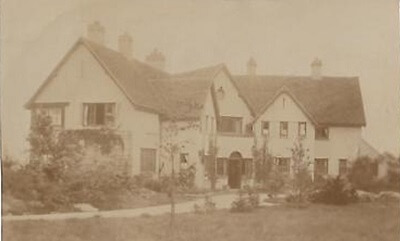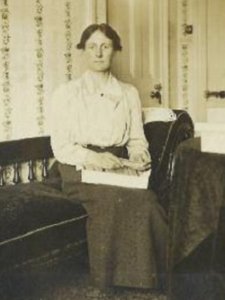Catharine Courtauld (1878-1972) and Sydney Renée Courtauld (1873-1962)

From 1910 the Mid Bucks Suffrage Society was centred round Great Missenden, particularly at Bocken, Frith Hill, where wealthy artist and sculptor Catharine Courtauld lived with her elder sister Sydney Renée Courtauld. Garden parties were held in Bocken’s extensive grounds to raise money to fund the cause. The house was built in the Arts and Crafts style in 1910 by architect and MP John Sewell Courtauld for his sisters. One of Catharine’s sculptors, a sea frieze survives in a bathroom at Bocken. The name derives from Bocking, a village near Braintree in Essex. This was the sisters’ family home and where part of the family’s textile business was based.
As Unitarians, the Courtaulds were supporters of social reform and of suffrage. Their mother was particularly keen on supporting education for all and served on many school boards. In 1866 two members of the family signed the first mass suffrage petition to Parliament, considered to be the birth of the modern suffrage movement. The family used their wealth to support their community through hospitals, educational trusts, and charitable funds. Other brothers Stephen and Samuel were both philanthropic patrons of the arts. Sir Stephen restored Eltham Palace in South-East London and Samuel founded the Courtauld Institute.
Catharine’s cousin, Katherina Mina Courtauld, known as Min, was also a committed suffragist. In the 1911 census she spoiled her return by writing at the bottom of the form ‘As a householder and ratepayer I deeply resent being denied the privilege of a citizen in the exercise of the parliamentary franchise’. Another cousin, Elizabeth, Min’s half-sister, had qualified as a doctor in 1901. During WWI she served as the principal anaesthetist at Royaumont Hospital. This hospital, 30 km north of Paris was run by the Scottish Women’s Hospital Service and funded by the NUWSS. She was awarded the Croix de Guerre by the French Government for her work.

Catharine was a founder member of the Suffrage Atelier and the Artists’ Suffrage League and used her art for the cause. Her Suffrage Atelier posters were often witty, such as the ‘Prehistoric Argument’ and the ‘Anti-Suffrage Ostrich’ and were widely distributed as postcards. ‘Waiting for a Living Wage’ was inspired by the chainmakers’ strike in Cradley Heath, West Midlands when women workers went walked out.
In 1912, whilst sailing to Australia with Renée on the cadet training clipper, Port Jackson, Catharine met and fell in love with Wilfred Dowman, who unfortunately was already married. They later lived together and in 1918, Catharine changed her surname to Dowman by deed poll. Soon after his wife started divorce proceedings and Catharine and Wilfred were finally married in 1920.
The Dowmans bought and restored the 19th Century British tea clipper Cutty Sark to be used as a cadet training ship and exhibited in Falmouth. It was the first historic ship to be open to visitors since Francis Drake’s Golden Hind. After her husband’s death, Catharine gave the ship to the Thames Nautical Training College for ten shillings, with a dowry of £5,000 for its upkeep, and from there it passed to the Cutty Sark Trust. The trust now has the clipper on permanent display in Greenwich, where it has become a popular tourist attraction.
Renée campaigned for women to have full access to Cambridge University, where she had studied at Newnham College from 1892-4. She joined the Women’s University Settlement which placed university-educated women in deprived areas of London as social workers. The society aimed to improve the welfare of poorer women and children through social care and education.
In addition to her work for the Mid Bucks Suffrage Society, Renée was a member of the London Society for Women’s Suffrage and served as secretary of the North and East Essex branch of the NUWSS in 1913. She also donated to the National Society for Equal Citizenship which evolved from the NUWSS. Renée never married. After her sister’s marriage she moved to Potten End where she donated land and a community hall to the village. In 1937 she donated money to secure part of the Ashridge Estate for the National Trust.
During the war, the Mid Bucks Suffragists followed Millicent Fawcett’s instruction and stopped actively campaigning for the vote. Instead they put their administrative and fundraising skills to use for the war effort principally funding hospital beds and medical supplies. Many of our local suffragists had hospital beds and even whole wards named after them. The Common Cause of 21 September 1917 lists Catherine and Renée Courtauld as both donating £100 (over £8,000 today) to the Scottish Women’s Hospital Service.

